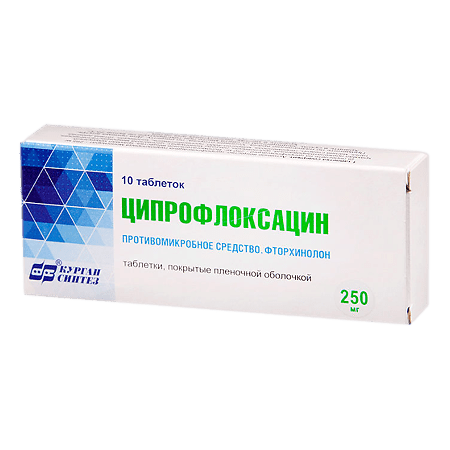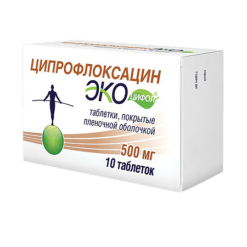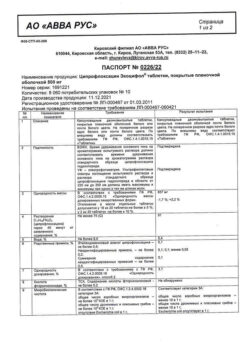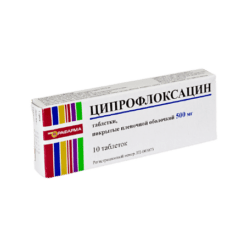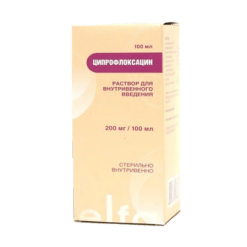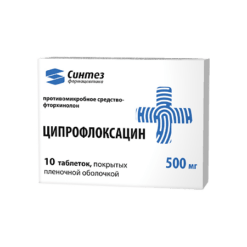No products in the cart.
Ciprofloxacin, 250 mg 10 pcs
€0.83 €0.69
Out of stock
(E-mail when Stock is available)
Description
Pharmacotherapeutic group
Antimicrobial agent, fluoroquinolone
ATX Code
J01MA02
Pharmacodynamics:
The broad spectrum antimicrobial agent quinolone derivative inhibits bacterial DNA-gyrosis (topoisomerases II and IV responsible for the process of superspiralization of chromosomal DNA around nuclear RNA which is necessary for reading genetic information) disrupts DNA synthesis growth and division of bacteria; causes pronounced morphological changes (including cell wall, membrane and membrane).cell wall and membranes) and rapid death of the bacterial cell.
It acts bactericidally on Gram-negative microorganisms during resting and dividing (as it affects not only DNA-giase but also causes lysis of cell wall) on Gram-positive microorganisms – only during dividing.
Low toxicity for macroorganism cells is explained by the absence of DNA-hyrase in them. During ciprofloxacin administration there is no parallel development of resistance to other antibiotics which do not belong to gyrase inhibitors group which makes it highly effective against bacteria resistant to, for example, aminoglycosides, penicillins, cephalosporins, tetracyclines.
Ciprofloxacin is sensitive to Gram-negative aerobic bacteria: Enterobacteriaceae (Escherichia coli Salmonella spp. Shigella spp. Citrobacter spp. Klebsiella spp. Enterobacter spp. Proteus mirabilis Proteus vulgaris Serratia marcescens Hafnia alvei Edwardsiella tarda Providencia spp. Morganella morganii Vibrio spp. Yersinia spp.) other gram-negative bacteria (Haemophilus spp. Pseudomonas aeruginosa Moraxella catarrhalis Aeromonas spp. Pasteurella multocida Plesiomonas shigelloides Campylobacter jejuni Neisseria spp.) some intracellular pathogens – Legionella pneumophila Brucella spp. Listeria monocytogenes Mycobacterium tuberculosis Mycobacterium kansasii; Gram-positive aerobic bacteria: Staphylococcus spp. (Staphylococcus aureus Staphylococcus haemolyticus Staphylococcus hominis Staphylococcus saprophyticus) Streptococcus spp. Bacillus anthracis is also sensitive to ciprofloxacin.
Most methicillin-resistant staphylococci are also resistant to ciprofloxacin. The sensitivity of Streptococcus pneumoniae Enterococcus faecalis Mycobacterium avium (located intracellularly) is moderate (high concentrations are required for their suppression).
Bacteroides fragilis Pseudomonas cepacia Pseudomonas maltophilia Ureaplasma urealyticum Clostridium difficile Nocardia asteroides are resistant to the drug. It is not effective against Treponema pallidum.
Resistance develops very slowly because after the action of ciprofloxacin there are practically no persistent microorganisms and on the other hand bacterial cells have no enzymes which inactivate it.
Pharmacokinetics:
Pharmacokinetics. When administered orally, it is rapidly and quite completely absorbed from the gastrointestinal tract (mainly in the 12 duodenum and jejunum). Food intake slows down absorption but does not change maximum blood concentration (Cmax) and bioavailability. Bioavailability – 50-85% volume of distribution – 2-3.5 l/kg binding to plasma proteins – 20-40%. Time of maximum drug concentration in blood (Tcmax) after per oral administration – 60-90 min, maximum drug concentration in blood (Smax) depends linearly on the dose taken and is 1.2 2.4 and 5.4 mcg/ml at doses of 250 500 750 and 1000 mg, respectively. Twelve hours after oral doses of 250,500 and 750 mg, the plasma concentration of the drug decreases to 0.1 0.2 and 0.4 mcg/ml, respectively.
The drug is well distributed in body tissues (excluding fat-rich tissue such as nerve tissue). Concentrations in tissues are 2-12 times higher than in plasma. Therapeutic concentrations are achieved in saliva tonsils liver gallbladder bile intestine abdominal and pelvic organs (endometrium fallopian tubes and ovaries uterus) seminal fluid prostate tissue kidney and urinary organs lung tissue bronchial secretion bone tissue muscle synovial fluid and articular cartilage peritoneal fluid skin. Small amount of cerebrospinal fluid penetrates the cerebrospinal fluid, where its concentration in the absence of inflammation of the meninges is 6-10% of that in blood serum, and 14-37% in inflamed ones. Ciprofloxacin also penetrates well into the ocular fluid pleura peritoneal lymph through the placenta. Concentration of ciprofloxacin in neutrophils is 2-7 times higher than in blood serum.
It is metabolized in the liver (15-30%) with the formation of slightly active metabolites (diethylcyclofloxacin sulfociprofloxacin oxociprofloxacin formylciprofloxacin).
The elimination half-life (T1/2) is about 4 hours with chronic renal failure up to 12 hours. It is eliminated mainly by the kidneys by tubular filtration and tubule secretion unchanged (40-50%) and as metabolites (15%), the rest – through the gastrointestinal tract. A small amount is excreted with breast milk.
Renal clearance is 3-5 ml/min/kg; total clearance is 8-10 ml/min/kg.
In chronic renal failure (creatinine clearance (CK) greater than 20 ml/minute) the percentage of the drug excreted through the kidneys decreases, but there is no cumulation in the body due to compensatory increase of the drug metabolism and excretion through the gastrointestinal tract.
Indications
Indications
Infectious and inflammatory diseases caused by susceptible microorganisms:
Children.
Active ingredient
Active ingredient
Composition
Composition
Active ingredient:
Ciprofloxacin hydrochloride monohydrate (in terms of ciprofloxacin) – 250 mg.
Auxiliary substances: starch, magnesium stearate, colloidal silicon dioxide, sodium carboxymethyl starch, lactose, microcrystalline cellulose, povidone, propyl parahydroxybenzoate, methyl parahydroxybenzoate.
The film coating: talc, diethyl phthalate, hypromellose.
How to take, the dosage
How to take, the dosage
Ingestion. Tablets should be swallowed whole with a small amount of liquid after a meal. When taking the tablet on an empty stomach the active ingredient is absorbed more quickly.
Infections of the lower respiratory tract of mild to moderate degrees – 0.5 g 2 times a day, with a severe course – 0.75 g 2 times. The course of treatment is 7-14 days.
In acute sinusitis 0.5 g 2 times a day. The course of treatment is 10 days.
Infections of the skin and soft tissues with mild to moderate degree – 0.5 g 2 times a day with a severe course – 0.75 g 2 times. The course of treatment is 7-14 days.
Infections of bones and joints of mild and moderate degree – 0.5 g 2 times a day with a severe course – 0.75 g 2 times. The course of treatment is up to 4-6 weeks.
Infections of the urinary tract infections – 0.25-0.5 g 2 times a day; course of treatment – 7-14 days with uncomplicated cystitis in women – 3 days.
In chronic prostatitis 0.5 g 2 times a day, the course of treatment is 28 days.
In uncomplicated gonorrhea – 0.25-0.5 g once.
Infectious diarrhea – 0.5 g 2 times the course of treatment – 5-7 days.
In typhoid fever – 0.5 g 2 times; course of treatment – 10 days.
In complicated intra-abdominal infections – 0.5 g every 12 hours for 7-14 days.
For prevention and treatment of inhalational anthrax – 0.5 g 2 times a day for 60 days.
In pediatrics:
In the treatment of complications caused by Pseudomonas aeruginosa in children with pulmonary cystic fibrosis from 5 to 17 years – 20 mg/kg 2 times a day (maximum dose 1.5 g). The duration of treatment is 10-14 days.
In case of inhalational anthrax (prevention and treatment) – 15 mg/kg 2 times a day. Maximum single dose is 0.5 g daily – 1 g. Total duration of ciprofloxacin therapy is 60 days.
In chronic renal failure: in creatinine clearance more than 50 ml/min the dose adjustment is not required; in IQ 30-50 ml/min – 0.25-0.5 every 12 hours; in IQ 5-29 ml/min – 0.25-0.5 g every 18 hours. If a patient is undergoing hemodialysis or peritoneal dialysis – 0.25-0.5 g/day, but the drug should be taken after hemodialysis session.
Interaction
Interaction
Treatment: no specific antidote known. Gastric lavage and other first aid measures Careful monitoring of the patient, ensuring adequate fluid intake. Only small amounts (less than 10%) of the drug may be eliminated by hemo- or peritoneal dialysis.
Interaction with other medicinal products. Due to decrease of microsomal oxidation activity in hepatocytes, it increases concentration and prolongs T1/2 of theophylline (and other xanthines such as caffeine) of oral hypoglycemic drugs indirect anticoagulants decrease prothrombin index.
In combination with other antimicrobial drugs (beta-lactam antibiotics aminoglycosides clindamycin metronidazole) synergism is usually observed; it can be successfully used in combination with azlocillin and ceftazidime in infections caused by Pseudomonas spp.with meslocillin azlocillin and other beta-lactam antibiotics in streptococcal infections; with isoxazolylpenicillin and vancomycin in staphylococcal infections; with metronidazole and clindamycin in anaerobic infections.
The nephrotoxic effect of cyclosporine is increased serum creatinine in these patients requires monitoring of this index 2 times a week.
When taken concomitantly, it increases the effect of indirect anticoagulants.
Orally if combined with iron-containing medications sucralfate and antacids containing magnesium, calcium or aluminum decreases absorption of ciprofloxacin; therefore, it should be taken 1-2 hours before or 4 hours after taking the above mentioned drugs.
Non-steroidal anti-inflammatory drugs (excluding acetylsalicylic acid) increase the risk of seizures.
Didanosine decreases absorption of ciprofloxacin due to its formation of complexes with aluminum and magnesium in didanosine.
Methoclopramide accelerates absorption which leads to shorter time to reach maximal blood concentration of the drug.
The co-administration of uricosuric drugs leads to slower excretion (up to 50%) and increased plasma concentration of ciprofloxacin.
Enhances Cmax 7-fold (4 to 21-fold) and AUC 10-fold (6 to 24-fold) of tizanidine which increases the risk of marked reduction of blood pressure and somnolence.
Special Instructions
Special Instructions
Ciprofloxacin is not the drug of choice for suspected or established Streptococcus pneumoniae.
In order to avoid the development of crystalluria, the recommended daily dose should not be exceeded, and adequate fluid intake and maintenance of an acidic urine reaction are also necessary.
Patients with a history of epilepsy, history of seizures, vascular disease and organic brain damage due to the risk of adverse central nervous system reactions should only be prescribed ciprofloxacin for “vital” indications.
In case of severe and prolonged diarrhea during or after treatment the diagnosis of pseudomembranous colitis must be excluded which requires immediate withdrawal of the drug and appropriate treatment.
In case of tendon pain or the first signs of tendovaginitis the treatment should be discontinued (there are some cases of inflammation and even tendon rupture during treatment with fluoroquinolones).
At all times during treatment, contact with UV rays (including direct sunlight) should be avoided.
Attention should be avoided during treatment for potentially hazardous activities that require increased attention and mental and motor responsiveness.
Contraindications
Contraindications
Hypersensitivity; concomitant use of tizanidine (risk of marked decrease in blood pressure drowsiness); childhood age (up to 18 years – until the completion of skeletal formation except for the therapy of complications caused by Pseudomonas aeruginosa in children with cystic fibrosis from 5 to 17 years; prevention and treatment of inhalational anthrax); pregnancy lactation period; lactose intolerance lactase deficiency glucose-galactose malabsorption.
Developed cerebral vascular atherosclerosis cerebral circulatory disorders mental illness epilepsy marked renal and/or hepatic insufficiency elderly age tendon lesions in previous treatment with fluoroquinolones.
Side effects
Side effects
Digestive system disorders: nausea diarrhea vomiting abdominal pain flatulence decreased appetite cholestatic jaundice (especially in patients with undergone liver disease) hepatitis hepatonecrosis.
Nervous system disorders: dizziness headache increased fatigue anxiety tremor insomnia “nightmare” dreams peripheral paralgesia (abnormal perception of pain sense) increased sweating increased intracranial pressure confusion depression hallucinations as well as other manifestations of psychotic reactions (occasionally progressing to states in which the patient can harm himself) migraine fainting cerebral artery thrombosis.
Sense organs: disorders of taste and smell visual disturbances (diplopia change in color perception) tinnitus tinnitus decrease in hearing.
Cardiovascular system disorders: tachycardia disorders of heart rhythm decrease in blood pressure.
Hematopoietic system: leukopenia granulocytopenia anemia thrombocytopenia leukocytosis thrombocytosis hemolytic anemia.
Laboratory indicators: hypoprothrombinemia increased activity of “hepatic” transaminases and alkaline phosphatase hypercreatininemia hyperbilirubinemia hyperglycemia.
Urinary system disorders: hematuria crystalluria (especially in alkaline urine and low diuresis) glomerulonephritis dysuria polyuria urinary retention albuminuria urethral bleeding decrease of renal nitrogen excretion function interstitial nephritis.
Allergic reactions: skin itching urticaria blistering accompanied by bleeding and appearance of small nodules forming scabs drug fever pinpoint hemorrhages on skin (petechiae) facial or laryngeal edema eosinophilia vasculitis nodular erythema multiforme erythema exudative (including Stevens-Johnson syndrome).Stevens-Johnson syndrome) toxic epidermal necrolysis (Lyell’s syndrome).
Musculoskeletal system: arthralgia arthritis tendovaginitis tendon ruptures myalgia.
Others: asthenia hypersensitivity to light superinfections (candidiasis pseudomembranous colitis) “flushes” of blood to the face.
Similarities
Similarities
Additional information
| Weight | 0.012 kg |
|---|---|
| Shelf life | 4 years. Do not use after the expiration date. |
| Conditions of storage | In a dry place protected from light at a temperature not exceeding 25 ° C. Store out of the reach of children. |
| Manufacturer | Sintez OAO, Russia |
| Medication form | pills |
| Brand | Sintez OAO |
Other forms…
Related products
Buy Ciprofloxacin, 250 mg 10 pcs with delivery to USA, UK, Europe and over 120 other countries.

